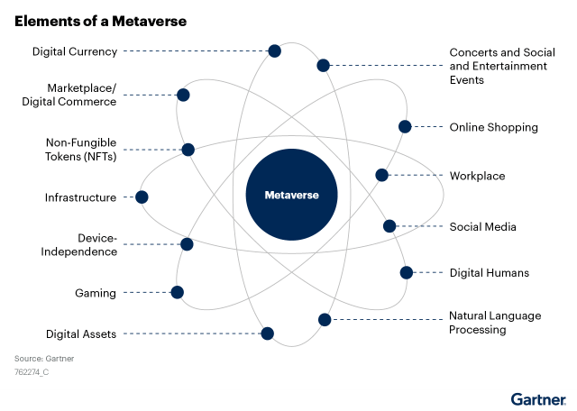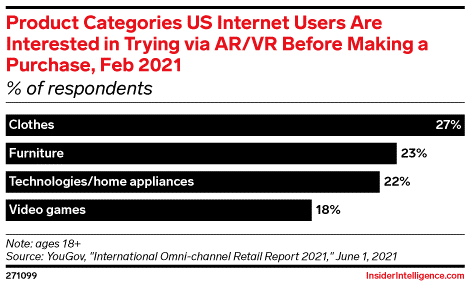.webp)
Sign up to receive latest insights & updates in technology, AI & data analytics, data science, & innovations from Polestar Analytics.
"See you in the metaverse!" is a phrase that is becoming very popular; it is predicted that we will be spending an hour a day in the virtual world by 2026. The same report by Gartner has also predicted that by 2026, 30% of corporations in the world will have services and products ready for the Metaverse.
Many businesses are keenly unlocking various contemporary opportunities in the Metaverse, as it has become crucial for companies to produce a cohesive customer experience by bridging the physical and digital worlds. But before diving into the blog, let's know about Metaverse.
The Metaverse is a virtual world in a virtual universe where people can communicate, engage, play, and work by creating their avatars. The base of the Metaverse is immersive technologies and experiences, which refer to the real-time digital 3D and photo-realistic environments, people, and things that users can experience as an entire world. See the image below, how Gartner defines its elements.
A few years back, virtual worlds were seen as absurd, but in the current scenario, more than individuals, the brands and retail industry must look forward to the rapidly growing virtual worlds. The Metaverse is the newest possibility for brands to reach, connect and create relationships with a new set of audiences.
However, the retail sector faces challenges and heavy competition on multiple fronts, such as customer service, active customer engagement, customer retention, and loyalty building. To address these issues, players are looking at the Metaverse as a solution to recreate the in-store experience of not only physical clothing stores but also furniture and automobile showrooms, etc.

The pandemic outbreak has accelerated the shift to digital consumption, which changed consumer experiences and expectations. Likewise, it enhanced the need for human interaction and a sense of community. Shopping malls are already centers for these connections: hubs for culture, wellness and leisure, as well as for physical shopping. And this role is set to strengthen as retailers evolve to relentlessly carry online experiences into physical spaces and vice versa, a fusion of both worlds to become "phygital." It is a mouthful but very real and coming to your neighborhood soon.
To thrive, physical retailers must innovate and give their customers the best of the digital and the physical and opportunities to move quickly between the two.
Retail as an industry has evolved a lot. From buying products in a barter system, street-side shops, and marketplaces to shopping malls, online shopping, digital marketplaces, and now shopping in the virtual world, the transition has been enormous.
The retail industry has opted for an omnichannel approach in the past decade, wherein brands have been looking at combining digital and physical retail. To bridge the gaps between digital and physical retail experiences, brands are exploring the utilization of the Metaverse to offer a multi-sensory and immersive experience to their consumers, which is lacking in the current digital scenario.
The Metaverse is a promising space now. Combined with virtual and augmented reality (VR/AR) devices, it can transform the retail industry considerably.
Retail stores can give customers better engagement and a 3D visual experience through the Metaverse by closing the 'immersive experience' gap effectively. Currently, popular online shopping platforms cannot provide such an experience, resulting in customers opting for offline product tryouts followed by an online purchase (showrooming) or drop-offs. In the Metaverse, customers can try out numerous products from the solace of their homes while avoiding the efforts that shopping in physical stores could include.

Numerous brands that have grabbed the metaverse concept have introduced their shoppers to a virtual shopping experience. This allows shoppers to venture around all the store floors, try on products and buy them – all without leaving their homes. For instance, a popular retail clothing brand has launched its first virtual store that allows consumers to shop in a 3D environment. Another leading cosmetic brand has adopted VR and AR through a make-up app that uses facial recognition to enable customers to try on products remotely.
A crucial attribute of the Metaverse is the use of personalized digital avatars. This offers brands in-depth real-time insights into their consumers' preferences. Brands can utilize these insights to improve their services and build consumer loyalty through retail analytics. For instance, a famous luxury brand has started selling accessories and virtual handbags for digital avatars in the Metaverse. This concept of fashion accessories and virtual bags will assist in brand positioning because as the Metaverse inflates and people become more brand conscious concerning their avatars, it's likely that the prices of these designer goods will skyrocket. As a result, more brands in the luxury segment will start selling virtual accessories and clothing.
A metaverse store can be accessed from anywhere in the world. Therefore, the Metaverse can assist brands to increase their visibility and widen their consumer base with the help of retail data analytics. A good space for positioning and branding ads in the Metaverse is within online games. This involves selling clothing to digital avatars and creating co-branded virtual environments where gaming interactions occur. For instance, a multinational consumer goods company recently partnered with a gaming platform to curate realistic skin types for player avatars, such as numerous facial features. Hence, branding in the Metaverse will be a game changer in the coming times.
Another way, retailers utilizing the Metaverse is through targeted segmented and targeted marketing. Retailers hurling the latest product lines in the Metaverse can gamify their offerings and products. This attractive marketing exercise could increase a customer's average time on the brand. This innovative gamified activity could also attract consumers, especially the Gen Z demographic, to try the items.
Therefore, retail players must explore the Metaverse and prepare to adopt it for digital asset curation. As this tech evolves and more organizations establish a presence, businesses that relentlessly blend the two worlds – virtual and physical – and deliver quality consumer experiences across the board are the ones that are likely to succeed.
So, What has your experience been with metaverse-related opportunities in the Retail industry? Please let us know what you think.
About Author

Content Architect
The goal is to turn data into information, and information into insights.